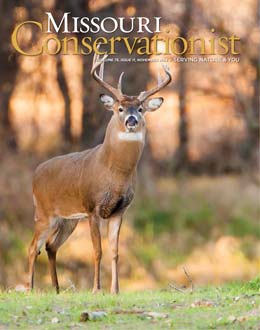What Is It?
Our photographers have been busy exploring the intricacies of the Missouri outdoors. See if you can guess this month’s natural wonder.

Ask the Ombudsman
Q: My son found a large (3.5-foot-tall and 4- to 5-foot-wide) ground nest on his property in Vernon County. There is a raccoon skull and other stuff in it along with the numerous pieces of blackberry stems, of which the nest is constructed. Is it a pack rat’s nest?
A: Yes, that is a nest of a type of pack rat called the eastern wood rat (Neotoma floridana). The species is native to Missouri and occurs primarily in the southern half of the state. Although abundant in some areas, it is not common over much of its Missouri range. Outside of the state, the species is found over much of the southeastern U.S., in several New England states, and west to eastern Colorado and central Texas. Wood rats are almost entirely vegetarians, only occasionally eating insects, dead birds, or snails. They have the habit of collecting shiny objects and taking them to their nest or nest area. When they “trade” what they are carrying for a more attractive object, a nearby camper may find a pile of sticks in place of a missing pocketknife, keys, or rifle cartridge.
Q: I have an ash tree that has some odd, dark-colored growths attached to the bare twigs. Can you tell me what it is and if it’s a concern for the tree’s health?
A: You are probably observing ash flower galls, a type of distorted growth of the male flowers, found on male ash trees. The galls are the result of the early spring feeding of a tiny mite called an eriophyid mite. The tree reacts to the feeding by growing the abnormal tissue that enlarges the male flowers, forming the gall. The galls start out green but darken to brown during the growing season and can remain on the tree for two years. They are most visible when the leaves are off the tree. No treatment is usually recommended because the galls are a cosmetic issue rather than a tree health concern.
Note to readers: This is my last column as I am retiring from the Conservation Department after 28.5 years of service, the last six of those years as the ombudsman. It has been a pleasure answering your questions and sharing with you some of the interesting tidbits of Missouri’s natural history. Thank you for your interest in the natural world and for your continuing support for conservation.
The ombudsman will respond to your questions, suggestions, or complaints concerning the Conservation Department or conservation topics.
· Address: PO Box 180, Jefferson City, 65102-0180.
· Phone: 573-522-4115, ext. 3848
· Email: Ombudsman@mdc.mo.gov
Agent Notes
Don’t Forget to “Bag Your Deer”
With the firearms deer season upon us, more than 500,000 hunters will be heading to the Missouri outdoors this November. Deer hunting adds $1.1 billion to the Missouri economy, creates more than 11,000 jobs for Missourians, and provides more than 250,000 pounds of meat to families in need through the Share the Harvest program. With all the benefits and enjoyment that comes from this amazing pastime, let’s help ensure that it will continue for years to come. Presenting a positive image of hunting to those who may not understand this key tool in deer herd management is important.
Dispose of deer remains where harvested, if possible. If you live in a rural setting, remains can be disposed of on your property, where they will not be offensive to neighbors. Nature will take care of the rest. For those in urban areas, simply bag up the remains and dispose of them with the rest of your garbage.
This deer season, as you enjoy the hunt, remember to dispose of deer remains properly and help represent a wonderful tradition in a positive light.
Jerid Wilkinson is the conservation agent for Newton County. If you would like to contact the agent for county, phone your regional conservation office.
What Is It?
Frost Flower

Not really a flower at all, frost flowers are delicate, beautiful ribbons of ice crystals that form on the lower stems of a few species of Missouri native plants. They occur only in late fall after the first few hard freezes and while the ground is still warm. Their season is brief, and they disappear quickly on the day they occur, melting when the air warms or rays of sunlight fall on the delicate structures. While the plants’ stems are ruptured by the first hard freeze, the root system is still sending up plant sap from the warmer ground. The sap pushes through the broken stem and freezes on contact with the cold air. As more sap moves up, it forces the freezing stream of white ice crystals into ornate, folded ribbons that look like petals, puffs of cotton candy, or snarls of white thread. Missouri plants known to produce frost flowers include dittany, stinkweed, and white crownbeard. Scientists don’t know what it is about these species that allow them to produce frost flowers. Perhaps their root systems are more active later in the year than other species, or their stems rupture in just the right way to force the ribbons of sap. Whatever the reason, frost flowers only appear on the stems of a few species. —photograph by David Stonner
And More...
This Issue's Staff
Managing Editor - vacant
Art Director - Cliff White
Staff Writer/Editor - Bonnie Chasteen
Staff Writer - Jim Low
Photographer - Noppadol Paothong
Photographer - David Stonner
Designer - Stephanie Thurber
Circulation - Laura Scheuler























